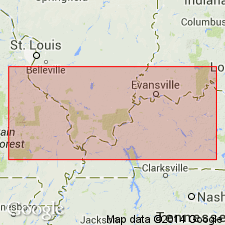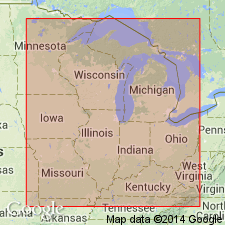
- Usage in publication:
-
- Lingle limestone
- Modifications:
-
- Named
- Dominant lithology:
-
- Limestone
- AAPG geologic province:
-
- Illinois basin
Summary:
Lingle limestone, here named, described as dark-colored, somewhat shaly hard, brittle limestone, carrying characteristic Hamilton fossils. Conformably overlies Misenheimer shale along a branch of Lingle Creek in Union Co., IL. Where Misenheimer shale is absent the Lingle rests unconformably on Grand Tower limestone or older beds. Underlies Upper Devonian Alto formation in southwestern IL. In eastern MO is overlain by post-Devonian rocks and underlain by Grand Tower limestone.
Source: GNU records (USGS DDS-6; Reston GNULEX).

- Usage in publication:
-
- Lingle Formation
- Modifications:
-
- Overview
- AAPG geologic province:
-
- Illinois basin
Summary:
Lingle Formation averages 15 m thick and reaches a maximum of 34 m in the subsurface of southeastern IL. There is no consistent basis for dividing the Lingle and overlying Alto into separate formations, but division is usually based on change in color. In study area, includes (ascending) Howardton Limestone, Tripp Limestone, Misenheimer Shale, and Walnut Grove Limestone Members. Overlies Grand Tower Limestone. Equivalent to St. Laurent Formation of MO. Age is Middle Devonian (late Eifelian to early Givetian).
Source: GNU records (USGS DDS-6; Reston GNULEX).

- Usage in publication:
-
- Lingle Formation*
- Modifications:
-
- Biostratigraphic dating
- AAPG geologic province:
-
- Illinois basin
Summary:
Lingle Formation includes middle Givetian coral ACANTHOPHYLLUM sp. and an undetermined ptenophyllid from a well sample in central IL.
Source: GNU records (USGS DDS-6; Reston GNULEX).
For more information, please contact Nancy Stamm, Geologic Names Committee Secretary.
Asterisk (*) indicates published by U.S. Geological Survey authors.
"No current usage" (†) implies that a name has been abandoned or has fallen into disuse. Former usage and, if known, replacement name given in parentheses ( ).
Slash (/) indicates name conflicts with nomenclatural guidelines (CSN, 1933; ACSN, 1961, 1970; NACSN, 1983, 2005, 2021). May be explained within brackets ([ ]).

